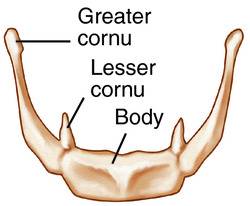Cards In This Set
| Front | Back |
|
What are the requirements for sound?
|
1) Source of Energy (Respiratory System)2) generate sound, something that vibrates (vocal folds)
|
|
What are the vegetative functions of the larynx?
|
-part of the airway-helps protect airway-exchange of gasses (oxygen and CO2)
|
|
Where is the larynx located?
|
-superior to top tracheal ring-attached to trachea via cricotracheal membrane-anterior to esophagus
|
|
What is cartilage?
|
-nonvascular connective tissue-more flexible than bone-calcifies (becomes bone-like. less flexible with age)-provides similar function as bone
|
|
What is the hyoid bone attached to?
|
-superior attach to cartilages of larynx-has about 30 muscular attachments
|
|
Greater Cornu (Horns)
|
-landmark of the hyoid bone-located on posterior end of horseshoe-attached to thyroid cartilage
|
|
Lesser Cornu (Horns)
|
 -part of the hyoid bone-points of attachment for muscles |
|
What is the cartilaginous framework for the larynx composed of?
|
-1 thyroid cartilage-1 cricoid cartilage-2 arytenoids-1 epiglottis-2 corniculates-2 cuneiforms
|
|
What is the thyroid cartilage of the larynx?
|
-largest of laryngeal cartilages-forms anterior/lateral walls of larynx-posterior opening (like hyoid bone)-2 large plates that come together to form an angle called the lamina (make up the thyroid notch-"Adam's Apple")
|
|
Oblique line of Thyroid Cartilage
|
-landmark that is on each of the thyroid lamina-raised surface, point of attachment for muscles
|
|
Superior horns/cornu of thyroid cartilage
|
-articulate with the greater horns of hyoid bone-thyroid ligaments that attach to where superior and greater horns attach
|
|
Inferior horns/cornu of thyroid cartilage
|
-articulate with the cricoid cartilage
|
|
What is the cricoid cartilage (1) of the larynx?
|
-forms base larynx (most inferior part of larynx)-sits on top of trachea-shaped like signet ring-criocid arch forms anterior/lateral surfaces
|
|
Arytenoid Cartilages (2) of the larynx
|
-triangular base, with the apex being at the top-vocal process: forward most (anterior) point of arytenoid cartilage. Vocal ligaments attach to this-muscular process: lateral point, muscular attachment (these muscles then help move the arytenoids)
|
|
Cricoarytenoid Joint
|
-arytenoids move on cricoid-glide toward midline and back toward lateral edge-movements help to control positioning and tension of the vocal folds
|



